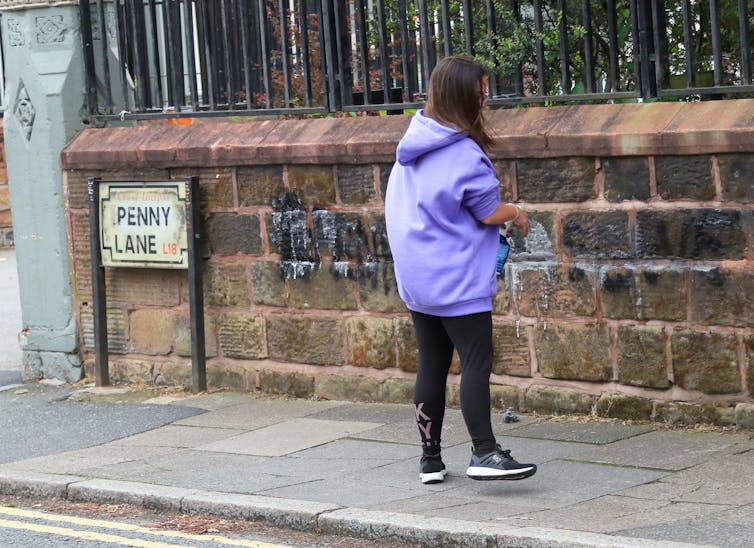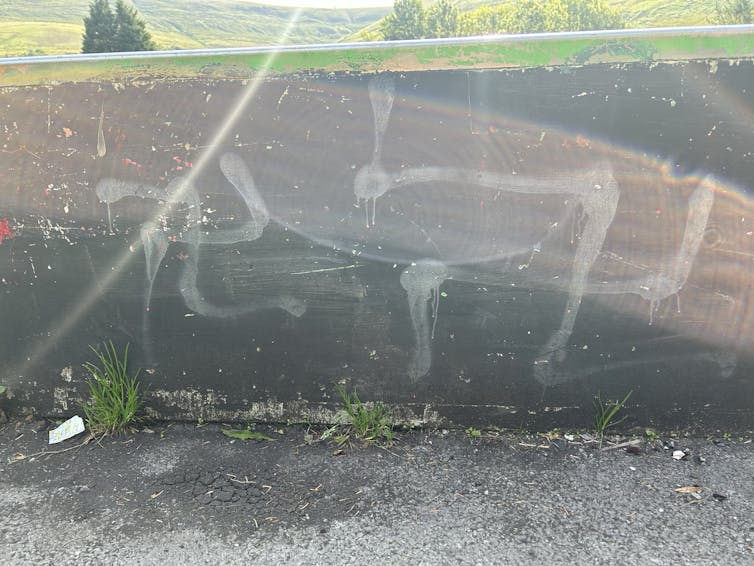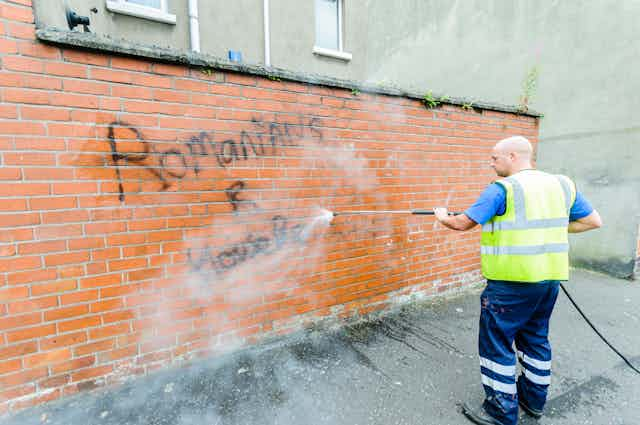Hateful graffiti and other imagery plague communities across the UK, spreading a toxic message of division. Such graffiti targets people based on race, religion, sexual orientation, disability and gender identity.
And sprayed graffiti is only one part of the problem. Hateful imagery can range from stickers and QR codes to leaflets, posters and engravings. These types of symbols and text can be used by organised extremist groups for coded communication, recruitment and to highlight their presence in an area.
Unfortunately, there is no comprehensive system for recording these types of images in the UK, so it’s difficult for researchers to understand the extent of the problem. This is why we’ve developed an app called StreetSnap to record instances of hateful graffiti and other visuals.
Hateful graffiti counts as a hate crime. Recent government figures show a 5% drop in hate crime. But since the start of the conflict in Israel and Gaza in October 2023, police have recorded a rise in religious hate crimes.
In November 2023, two London schools reported incidents of Islamophobic and antisemitic graffiti. The Weiner Holocaust Library and several other locations around London have been targeted by a spate of far-right racist graffiti.
Transphobic graffiti plagued various sites across Tyneside in 2023. While more than a third of graffiti in Edinburgh over the past five years was revealed to be racist or offensive.
More recently, following amendments to hate crime laws in Scotland, Scottish first minister Humza Yousaf became the target of Islamophobic and racist graffiti outside his home in Dundee.
Under-reporting
But while we have sporadic reports of such incidents in the news, the under-reporting of hate crime and issues with police data collection in some parts of the UK prevent us from seeing an accurate picture. The situation is compounded by an under-reporting of anti-social behaviour.
In recent years, there has been a drive to tackle different types of hate crimes through various government action plans and a parliamentary anti-hate crime group, which was launched in 2018.
The social, cultural and economic landscape is changing in the UK. Issues such as war, immigration, people seeking asylum and the rising costs of living are changing and challenging communities. As a result, it is now more important than ever that hateful graffiti and symbols are better understood. They need to be comprehensively identified, reported, removed and used for analysis by academics.
Unfortunately, general research on this topic is sparse. But one Australian study showed that hateful graffiti can heighten people’s perceptions of insecurity and fear of crime.
We also know that the fear of hate crime and antisocial behaviour in general influence the way people use places and interact with one another. For example, parents may become reluctant to let children play in certain parks, while women and girls may avoid walking in certain areas after dark.

Hateful graffiti, whether fuelled by malicious intent or simply ignorance, may have the same destructive effect on individuals, groups and communities. It could contribute to a climate where expressions of hate are considered commonplace, solely a part of the environment in which we live. This may lead to a troubling trend: the normalisation of hate.
Tolerance of hateful graffiti, and lack of action, can therefore suggest a message of silent acceptance, and implicit agreement within an area. This may help to imply who is welcome or belongs in an area, and those who do not because they are “different”. This could affect community cohesion and may cause local tensions.
Councils across the UK vary in their approaches to visual hate like graffiti but it is difficult to pin down any specific mandates regarding its removal. In 2014, the UK government’s then communities secretary, Eric Pickles, wrote to local authorities to draw attention to the effect of hateful graffiti on people and communities. The letter highlighted the importance of reporting and photographing instances before removal. But this is still being overlooked by councils, as we have discovered.
StreetSnap
Our app lets selected users like the police, councils, housing association staff and youth workers photograph hateful imagery and upload the pictures to a shared system.
Our intention is that this will allow for easier communication between various authorities, as well as identification and removal by councils. More importantly, though, the data gathered can be used to identify and understand patterns and help monitor community tensions.

It is currently being piloted by Bridgend County Borough Council in south Wales. Although it is still early days, the data being gathered is already helping the local authority to identify and remove hateful graffiti and other imagery.
We aim to refine the app so that it can be rolled out to other councils across the UK. This will hopefully lead to better data being gathered and studied in future.

